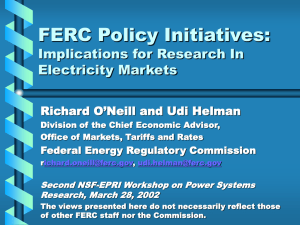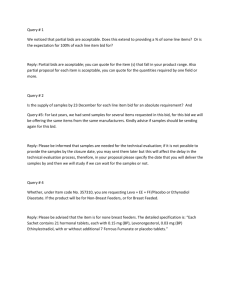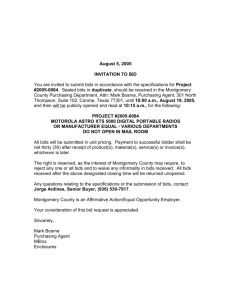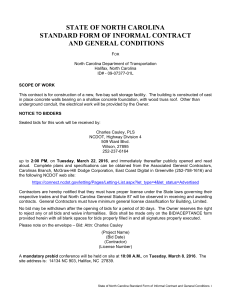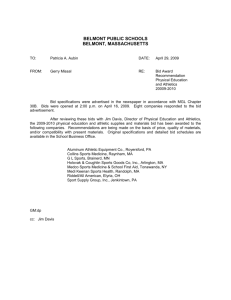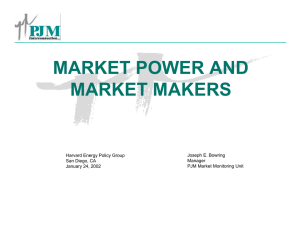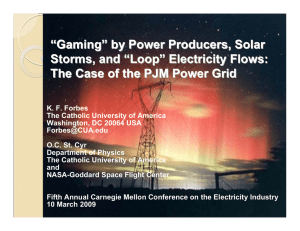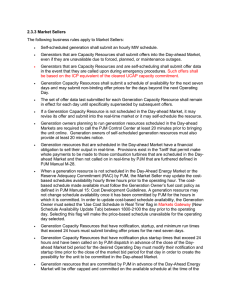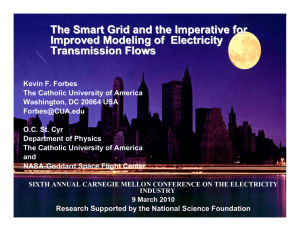ppt
advertisement
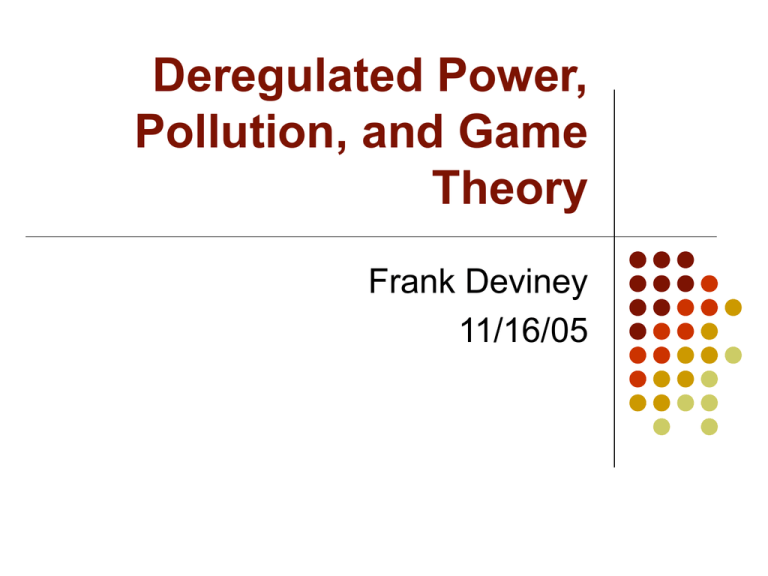
Deregulated Power, Pollution, and Game Theory Frank Deviney 11/16/05 My Questions How does deregulation affect the distribution of pollutant emissions? Can game theory help answer this question? Pollution – Cap and Trade SO2 allowances are allocated or auctioned After-market exists for trading allowances ~9 million allowances per year An allowance permits emission of a fixed amount of SO2 Local power plants Possum Point Mt Storm Bremo Bluff Fear – hot spots 0.001 lbs SO2/mmBtu 0.10 lbs SO2/mmBtu 1.45 lbs SO2/mmBtu 550+ MW 1600 MW 250 MW Power Grid Situation Problems under environment of deregulation Energy (Generation) pricing Congestion management and pricing Others Capacity expansion Reserve capacity Environmental/other constraints - 2004 - 2005 Generation Old Paradigm – minimize costs subject to “Keep the Lights On” constraint. A regulated monopolies environment. New Paradigm – Competition leads to efficiency. Maximize benefits for all. Game theory has been used to: Justify the switch Establish bidding procedures for participants Generation I Ferrero, Rivera, and Shahidehpour, 1998 Objective: maximize each participant’s benefit Assumptions (PoolCo model) Coordinator schedules (dispatches) generation beginning with lowest bid price until demand is met Generators receive the “spot price”, the max bid of all dispatched generators Assumption: spot price equal throughout the grid “sealed bids” – submit bids at same time Knows own cost but not others’ costs Knows others’ bid history, but not their benefit Gen costs are 2nd order fn of power output Generation I, cont. Aspects of the Game Formulated as non-cooperative, two-player Correlated costs allowed (used in the example) Strategy is to bid with respect to initial marginal cost (as if not in the market) Probability distribution of the game derived from available information, they use fuel prices in the example. Demonstrate analytical solution for Nash equilibria so presumably participant could use game theory to establish bidding positions Generation II Park, Kim, Kim, Jung, and Park 2001 Assumptions (PoolCo model) Total generation bids demand Individual generation bid < demand Demand is constant Transmission losses and congestion ignored Complete information available to all (apparently holds in some countries) Again the 2nd order cost function Generation allocation < last-dispatched unit, all generation offered = last-dispatched unit, split with others with equal bids Generation II, cont. Aspects of the Game Formulated as non-cooperative, two-player Strategy = (bid price, bid generation) in continuous space Suggest a hybrid approach combining analytical and graphical methods Inelastic demand Bidding price cap A question I have tended to think of the allowances as being a constraint on production. Generator’s goal is to maximize production or profit subject to the emission allowance constraint. Companies tend to re-distribute their allowances in-house rather than through the market. How does the existence of such global constraints affect the assumptions inherent in a non-cooperative game? How does PJM do it? As complicated as the game theory models may be, the actual market is more complicated Market Timelines Day-ahead Until noon – PJM receives bids and offers for energy for next day Noon until 4 p.m. Market is closed. PJM computes nextday LMPs. 4 p.m. PJM posts initial day-ahead LMPs. 4-6 p.m. Market re-opens for re-bidding. 6 p.m. – Day-ahead LMPs locked in. Remainder of day – PJM continually updates the dispatch list Real-time ? 5-minute intervals? What is congestion? When the economic dispatch solution cannot be implemented due to transmission line constraints. Congestion Silva, Wollenberg, and Zheng, 2001 Assumptions Constant marginal cost for generation Constant demand An “economic dispatch” solution exists Competitors will not provide cost information, but can estimate others’ costs Marginal cost domains are bounded The pdf is otherwise continuous Congestion, cont. Mechanism Design A mechanism is a game. Proposed game is that: Generators submit bids to agent Agent allocates production and reward Goal is to get generators to provide true cost bids Claim is that the proposed payment scheme achieves this What does PJM do? LMPs Implicit congestion – payments/receipts based on bus LMP explicit congestion – transactions pay differential between source and sink LMPs FTRs – Financial Transmission Rights Monthly, annual auctions Serve as a hedge against day-ahead uncertainty as to when and where congestion will occur.

